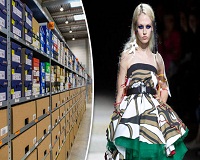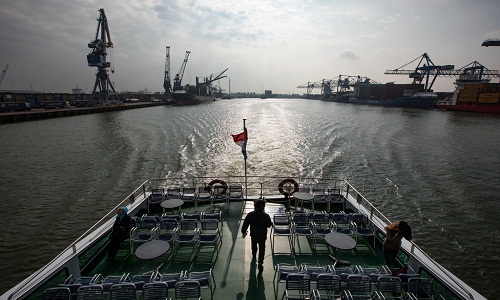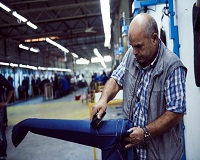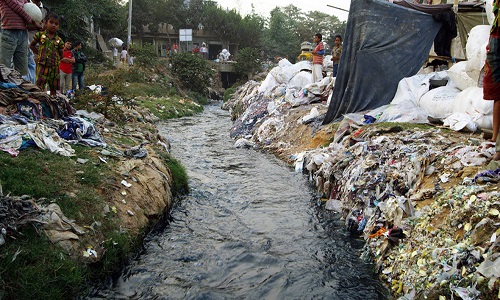FW
China, with support from the EU and Japan, is working to bring about changes to the WTO. China wants to curb the rise of unilateralism within the multilateral trading system represented by the WTO. It feels reforms in the organization need to address the concerns of members, especially emerging economies, which have a larger total population than developed countries.
The rapid growth of emerging economies has led to a shift in economic power. Emerging markets surpassed developed countries to account for more than half of world GDP on the basis of purchasing power in 2013. As their domestic markets and imports grow, emerging economies want to have a bigger say in international trade and economic negotiations.
WTO reforms cannot ignore China, which is the world's largest trading country. The majority of WTO members are developing countries, and each has its own ideas on WTO reform. China, like other emerging countries, follows a primary strategy of promoting economic and social development. The growing spending power of consumers in developing countries injects vitality into the global market.
China supports the work of the WTO but it is against the changes proposed by the US, Japan and EU on the notification system for domestic industrial subsidies. These countries and groups feel some WTO members such as China have failed to comply with a notification system.
Alibaba will partner 200 garment factories in China. The tie-up will assist garment factories to monitor their production data through the use of Artificial Intelligence (AI). Cameras will be installed for data collection. A retail management platform belonging to Alibaba will synchronize the production process through computer vision algorithms.
Each implementation takes approximately two days since no personnel training is involved in the installing and commissioning. The process of digital transformation includes the installation and repeated debugging of 20 cameras, hardware, fiber-optic networks and other equipment.
In this technology revamping process, factories’ scheduling performance has increased six per cent and delivery cycles have become ten per cent shorter. The retail management platform has also introduced an instant messaging platform to synchronize real-time information to all the factories involved in the project. The messaging platform will notify the progress of an order to everyone and a robot will text the responsible person if something goes wrong.
Alibaba is looking to help manufacturing companies innovate and upgrade. The current manufacturer-oriented industry will transition to a new era led by customers, where small- and medium-sized enterprises can benefit the most. So far some 20 factories have undergone technology revamping.
metakey: Alibaba
"Experts are recommending several unique ways to deal with Trump’s tariffs and adjust business models to cope. Darrin Beer, Western Regional Manager, CIT Commercial Services advices retailers and importers seek new sourcing alternatives. He feels the process of shifting sourcing overnight without risking quality, production schedules or both as virtually impossible. Therefore, he advices concerned US retailers and their suppliers to make their own decisions on how to engage with tariffs issue and whether to protest through trade groups or elected representatives."
 Experts are recommending several unique ways to deal with Trump’s tariffs and adjust business models to cope. Darrin Beer, Western Regional Manager, CIT Commercial Services advices retailers and importers seek new sourcing alternatives. He feels the process of shifting sourcing overnight without risking quality, production schedules or both as virtually impossible. Therefore, he advices concerned US retailers and their suppliers to make their own decisions on how to engage with tariffs issue and whether to protest through trade groups or elected representatives.
Experts are recommending several unique ways to deal with Trump’s tariffs and adjust business models to cope. Darrin Beer, Western Regional Manager, CIT Commercial Services advices retailers and importers seek new sourcing alternatives. He feels the process of shifting sourcing overnight without risking quality, production schedules or both as virtually impossible. Therefore, he advices concerned US retailers and their suppliers to make their own decisions on how to engage with tariffs issue and whether to protest through trade groups or elected representatives.
Tightening the supply chain
Sydnee Breuer, Executive Vice President, Rosenthal & Rosenthal recommends tightening the supply chain. She terms the idea of burdening factories entirely with tariffs as unrealistic. She feels tariffs will impact higher-end brands with their higher margins lesser than lower-margin and lower-priced private-label business. The lion’s share of this price increase will have to be borne by factories and importers, which in turn will compel them to trim their operating expenses.
terms the idea of burdening factories entirely with tariffs as unrealistic. She feels tariffs will impact higher-end brands with their higher margins lesser than lower-margin and lower-priced private-label business. The lion’s share of this price increase will have to be borne by factories and importers, which in turn will compel them to trim their operating expenses.
Rob Greenspan, President and Chief Executive, Greenspan Consult believes as companies affected by these tariffs will continue to look for sources of production outside China; they will try to pass these additional costs to the retailer, who will in turn, pass them to the consumer. This will refrain the consumers from buying the product.
Sunnie Kim, President and Chief Executive, Hana Financial is more concerned about the impact ib supply chain, resulting in lower sales and profits for clients and higher prices for consumers. The retail industry will likely be impacted in the same manner. While Robert Meyers, President, Republic Business Credit believes the tariffs will impact clients depending on their category, reliance on Chinese suppliers and the actual price sensitivity of customers. Small businesses like Flintridge Financial Solutions will have to pass on the higher prices to their customers, especially if they do significant business with major discount chains. However, bigger companies like Wells Fargo Capital Finance would ultimately raise their prices. They will continue to have the option of shifting to vendors with alternative supply chains.
Tariffs to open new avenues of growth
Ken Wengrod, President, FTC Commercial Corp urges companies to utilise and invest more in technology so they can speed up the creation-to-engineering process by cutting down sampling costs, improving yields on their raw materials and reducing idle times in transition, especially on the water. In similar fashion, US importers need to find alternative places of production within the US and Latin America to reduce their cycle time. The uneasiness of potential apparel tariffs will thus open business’s mindsets to welcome the change in environment.
"Only seven months remain for the UK to formally exit the European Union, and the £28 billion fashion sector has to get three different looks ready for future-proof business. As per Richard Lim, Chief Executive of Retail Economics, the potential scenarios would include ‘Hard Brexit’, where designers, retailers and manufacturers have to pay to trade with the EU. This would mean clothing and footwear tariffs of about 11 per cent or just over £1 billion more each year. A second option includes free trade agreement and a third option believes the UK would remain a part of the customs union. Lim believes, whatever happens, the price of a pair of jeans will, in all likeliness, go up post Brexit. Tariffs, and an exodus of (European) shop staff, designers, warehouse staff, delivery drivers would all add up to push up clothes prices in the UK."
 Only seven months remain for the UK to formally exit the European Union, and the £28 billion fashion sector has to get three different looks ready for future-proof business. As per Richard Lim, Chief Executive of Retail Economics, the potential scenarios would include ‘Hard Brexit’, where designers, retailers and manufacturers have to pay to trade with the EU. This would mean clothing and footwear tariffs of about 11 per cent or just over £1 billion more each year. A second option includes free trade agreement and a third option believes the UK would remain a part of the customs union. Lim believes, whatever happens, the price of a pair of jeans will, in all likeliness, go up post Brexit. Tariffs, and an exodus of (European) shop staff, designers, warehouse staff, delivery drivers would all add up to push up clothes prices in the UK.
Only seven months remain for the UK to formally exit the European Union, and the £28 billion fashion sector has to get three different looks ready for future-proof business. As per Richard Lim, Chief Executive of Retail Economics, the potential scenarios would include ‘Hard Brexit’, where designers, retailers and manufacturers have to pay to trade with the EU. This would mean clothing and footwear tariffs of about 11 per cent or just over £1 billion more each year. A second option includes free trade agreement and a third option believes the UK would remain a part of the customs union. Lim believes, whatever happens, the price of a pair of jeans will, in all likeliness, go up post Brexit. Tariffs, and an exodus of (European) shop staff, designers, warehouse staff, delivery drivers would all add up to push up clothes prices in the UK.
Efforts to ease bbtransition
Annually, the UK imports around £10 billion worth of clothes and shoes from Europe and more than 10,000 European staff work in the British fashion industry. It has become a microcosm of UK’s struggle to deal with the referendum result.
European staff work in the British fashion industry. It has become a microcosm of UK’s struggle to deal with the referendum result.
Katharine Hamnett sold thousands of ‘Cancel Brexit’ T-shirts and then went on to offer a new version: ‘Fashion Hates Brexit’ tees. While campaigning for a second referendum Hamnett also has a Plan B. She has set up her own Italian company, near Venice, ‘to handle production and logistics, so it doesn’t get snarled up in complicated Brexit red tape and import and export problems for its manufacturing and shipments’.
Francis Card, Fashion Consultant and former Matchesfashion.com COO laments the fact that the industry knows little about the Brexit deal is a concern. Her sentiments are echoed by Clare Hornby of ME+EM, whose Breton T-shirts are loved by the Duchess of Cambridge. Photographer Nick Knight believes Britain and its communities will be considerably worse off both economically and culturally if they leave the EU.
The devaluation of the Brexit-fuelled pound is surging the number of Chinese, Arab and American fashion tourists chucking cash at the West End’s fanciest tills. But to offset rising foreign manufacturing costs, an influx of shoppers needs to be balanced by an outflux of international talent from the industry. José Neves, Founder of luxury online platform Farfetch, believes if Brexit jeopardises the presence of 25 different nationalities in its London office, it’ll be a major loss.’ Many great British designers are European and proud of it’: Mary Katrantzou is Greek, Simone Rocha is Irish, Peter Pilotto is Austrian-Italian.
Drain of talent a concern
Another concern post Brexit is the talent drain. As Stephanie Phair, Chair British Fashion Council, points out ‘making sure young people from all around the world have access to creative education and skills to protect our home-grown talent pipeline’ is a post-Brexit priority. The BFC helps run the fashion arm of the Home Office’s Tier 1 visa scheme, giving 2,000 top designers from outside the EU fast-tracked visas. ‘In light of Brexit, this is something that is incredibly important.’ However, universities claim talent drain isn’t happening yet. The London College of Fashion says its proportion of EU applicants hasn’t dropped over the past year.
On the other hand there are people like Liam Fox, International Trade Secretary, who feel Brexit is ‘an unprecedented opportunity to create a trading environment that delivers for our country, our businesses and our citizens’. Brexit isn’t a wardrobe disaster for every London company in the fashion industry. The vote could help in the return of ‘Made in Britain’.
At the same time there is concern as a large number of designers, stitchers etc, are from mainland Europe. Also, UK apparel makers need something to make their clothes from — as three quarters of materials used in the UK are imported. If there is no deal, UK manufacturers will be subject to a bewildering array of tariffs.
In short, experts worry London may lose its reputation as a global fashion capital. Last month, Superdry founder Julian Dunkerton, gave £1 million to the People’s Vote campaign for a second referendum. And as Card points out UK has come back from a major exodus of designers and top models at London Fashion Week around a decade ago — it was hard to do. Brexit’s potential loss cuts through all aspects of the industry: it’s a disaster for stores, businesses and carefully nurtured brands, and the freedom to move everything and everyone easily across borders.
"Worldwide, approximately 80 billion garments are produced annually, which is equivalent to 11 pieces of clothing per person, per year. At the same time, the number of worn clothes being discarded is also growing. In Shanghai alone, hundreds of tons of garments are being discarded every day, equating to 130,000 tons a year. Denim manufacturers for the world’s top brands have steadily grown in Xintang, a town in the province of Guandong, where 60 per cent of China’s jeans are produced. Studies reveal, 260 million pairs of jeans were produced in Xintang in 2008 alone for export to Russia, the United States, and the European Union."
 Worldwide, approximately 80 billion garments are produced annually, which is equivalent to 11 pieces of clothing per person, per year. At the same time, the number of worn clothes being discarded is also growing. In Shanghai alone, hundreds of tons of garments are being discarded every day, equating to 130,000 tons a year. Denim manufacturers for the world’s top brands have steadily grown in Xintang, a town in the province of Guandong, where 60 per cent of China’s jeans are produced. Studies reveal, 260 million pairs of jeans were produced in Xintang in 2008 alone for export to Russia, the United States, and the European Union.
Worldwide, approximately 80 billion garments are produced annually, which is equivalent to 11 pieces of clothing per person, per year. At the same time, the number of worn clothes being discarded is also growing. In Shanghai alone, hundreds of tons of garments are being discarded every day, equating to 130,000 tons a year. Denim manufacturers for the world’s top brands have steadily grown in Xintang, a town in the province of Guandong, where 60 per cent of China’s jeans are produced. Studies reveal, 260 million pairs of jeans were produced in Xintang in 2008 alone for export to Russia, the United States, and the European Union.
While jeans registered the highest annual growth in 2017 since 2013 with over $95 billion in sales worldwide and the sales of premium designer jeans have doubled, there’s a dark side to it too. A recent documentary revealed one pair of jeans from Xintang sells for less than $11, yet 490,000 laborers depend on the factories for their livelihoods.
Denim garment business in Xintang began in 1980s and has been booming ever since. Factory workers can be seen everywhere in the town — mostly females — and some minors under 10 years. For tasks such as cutting thread, workers can earn 15 cents per piece or about $4 per day. In many factories, the machines never stop and workers rotate on shifts, six days a week. The rooms are noisy, hot, and humid and pungent with the smell of chemicals and dust, because the fans of heavy duty machines have not been cleaned in years, and the ventilation system is outdated. Such has been the plight of people working in the factories for many years.
Environmental implications
Every morning, workers must scoop the stones that are used to polish the jeans out of the wastewater, causing their fingers to turn blue from the toxic dyes and carcinogenic chemicals. This wastewater from the dying and polishing procedures is then discharged into the environment without any filtering or treatment. An investigation by Greenpeace in 2010 found at three sampling sites in Xintang, the amount of lead, copper, and cadmium in the riverbed exceeded the national soil quality standards, with one sample of river mud containing cadmium at levels that were 128 times over the safe limit. Blue plastic buckets filled with various chemical concoctions used in the intensive washing of the denim are stored in the factories’ washing departments. The jeans are washed over and over again to achieve the desired effect — sometimes up to 20 times. Carcinogenic substances from the chemicals become embedded in the denim and are slowly released, harming the health of the factory workers and potentially the consumers.
chemicals. This wastewater from the dying and polishing procedures is then discharged into the environment without any filtering or treatment. An investigation by Greenpeace in 2010 found at three sampling sites in Xintang, the amount of lead, copper, and cadmium in the riverbed exceeded the national soil quality standards, with one sample of river mud containing cadmium at levels that were 128 times over the safe limit. Blue plastic buckets filled with various chemical concoctions used in the intensive washing of the denim are stored in the factories’ washing departments. The jeans are washed over and over again to achieve the desired effect — sometimes up to 20 times. Carcinogenic substances from the chemicals become embedded in the denim and are slowly released, harming the health of the factory workers and potentially the consumers.
It’s estimated that 960 gallons of water is used for each pair of blue jeans produced. The wastewater, black, blue, or red in colour, is washed into rivers, where pollution has reached alarming levels. Some wastewater flows directly into the small local rivers and eventually flows to the Dongjiang River. Farmers near the river suffer from the stench of the water every day, as well as its pollution to their land and the effects on their crops. Using Google Map’s satellite view, one can see black waters from Dongjiang River near Dadun Village in Xintang flowing into the sea.
Spinexpo took place in China, September 4 to 6, 2018. This is an exhibition for fibers, yarns, knitwear, knitted fabrics and creative machinery. Exhibitors brought creativity and interesting fashion projects to the exhibition and helped enhance it aesthetically. The exhibition attracted 8,677 Chinese visitors and a total of 1,645 visitors from outside China. The atmosphere at this edition was positive, despite the current market uncertainties. Visitor numbers from Europe continued to increase, and the number of visitors from Taiwan grew considerably.
For the first time since its launch, Spinexpo presented developments in the socks sector. The general climate in the textile industry in Europe and the US is not very good, with Europe suffering real stagnation while results for the US have been below average. For many Chinese and non-Chinese exhibitors, the Chinese market has become essential for their results, as consumer growth in the mid to high end product sector in China has helped them cope with the fall in the markets of other continents.
Brands were increasingly looking for smarter, recyclable or eco-friendly products at a time when material purchase prices are far from favorable. Increase in price of raw materials has had an impact on collections of spinners, and consequently knitwear manufacturers, as well as on the sales prices of brands.
More and more Chinese textile companies are choosing weaving machines from Dornier to meet the growing demand for high quality technical fabrics for aircraft parts, filters, automotive and safety textiles. At the ITMA Asia International Textile Machinery trade fair in Shanghai (15-19 October), the German technology leader will exhibit the world‘s most advanced weaving technology for producing high performance fabrics.
Dornier will exhibit its new P2 rapier weaving machine in its most powerful configuration (Type: TGP). This machine is able to bring a reed beat-up force of up to five tons for producing wide, seamless fabrics for high density air and water filters. The weaving machines from Dornier have represented the gold standard for flawless processing of high-performance fibers such as carbon, glass fiber and aramid for over 60 years.
Besides the P2 TGP rapier weaving machine, Dornier will also exhibit an air-jet weaving machine for manufacturing car upholstery and an airbag weaving machine. The "Made in Germany“ label is highly regarded as a hallmark of quality in China, as is borne out by an ongoing project in the town of ürümqi.
Yarn production decreased nine per cent in the first quarter of 2018 across the world. Increases of three per cent in the US and 12 per cent in Brazil cancelled out production reductions of 13 per cent in Africa, 11 per cent in Asia and 1.5 per cent in Europe.
Global yarn orders decreased five per cent on an average in all countries, except in Japan where they increased two per cent. Most countries from Africa, Asia and North America are optimistic about the evolution in the second quarter, while Europe and Brazil expect a decline in production.
Global fabric production in the same comparative periods decreased 10 per cent, with a 12 per cent drop in Asia, a five per cent decline in Africa and a two per cent falloff in Europe. Brazil’s fabric production increased one per cent in the period. World fabric output reached 96 per cent of its first quarter 2017 level.
Global fabric orders fell six per cent in the first quarter from the fourth quarter. Europe’s two per cent gain was balanced out by reductions of ten per cent in Brazil and 18 per cent in Africa, which brought the global index to 88 per cent of its prior-year level.
Although the SDGs are still a relatively new idea in the business world, a growing number of brands and retailers are turning to the United Nations–adopted objectives as a kind of turnkey framework for achieving ambitious environmental, economic and social targets. Broken up into 169 specific benchmarks, the 17 SDGs encompass poverty eradication, gender equality, clean water and sanitation, clean and affordable energy, innovation and infrastructure, climate action and education.
These SDGs, related to fashion, are coming into focus at a time of escalating discourse about the $2.5 trillion industry’s social and environmental impacts. In July, Marie Chatardová, President of the UN Economic and Social Council, characterised the state of fashion as one of “environmental and social emergency.”
According to the UN, garment manufacturing emits 10 percent of carbon emissions (SDG 13), produces 20 percent of water, is often linked to dangerous working conditions (SDG 8) and contributes to deleterious health impacts from the use of hazardous substances during production (SDG 3. These SDGs can serve as a nice menu for companies to understand where they are making an impact and how they can have an impact.
H&M’s operating profit fell 19 per cent in the three months to August, marking the tenth decline in 12 quarters. Stock-in-trade rose 15 per cent. Record apparel backlogs have hit its profit. H&M’s inventories have been a persistent problem, rising steadily as the Stockholm-based fast-fashion chain failed to keep up with consumers’ tastes and was struck by logistics woes. The company is working through the excess stocks and will be able to scale back discounting as a result, even as it irons out its supply problems.
The retailer has taken the market share in most markets, largely because its new collections have been appreciated by customers. However, H&M won’t hit its sales growth target of 10 to 15 per cent this year. Online sales were a bright spot for H&M, rising 32 per cent, though the retailer still may struggle to reach its target for a full-year increase of at least 25 per cent because first-half e-commerce missed that level.
Weakness among clothing retailers has pitted them in a battle to lower prices. Sales at Gap, discount-clothing retailer Primark and Esprit have been under pressure, and Inditex reported its weakest sales growth in four years this month.












